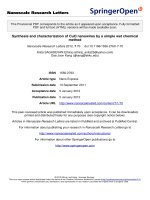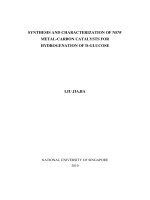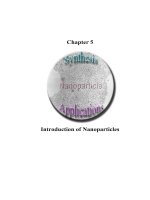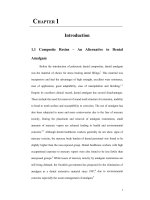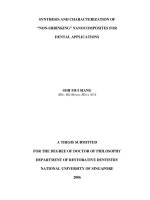Controlled synthesis and characterization of rGO materials by hydrothermal method
Bạn đang xem bản rút gọn của tài liệu. Xem và tải ngay bản đầy đủ của tài liệu tại đây (954.02 KB, 4 trang )
Journal of Science & Technology 135 (2019) 056-059
Controlled Synthesis and Characterization of rGO Materials by
Hydrothermal Method
Chu Thi Quy, Chu Manh Hung, Bui Thi Hang, Nguyen Duc Hoa*
Hanoi University of Science and Technology – No. 1, Dai Co Viet Str., Hai Ba Trung, Ha Noi, Viet Nam
Received: July 30, 2018; Accepted: June 24, 2019
Abstract
Oxidative exfoliation followed by chemical reduction is an effective method to synthesize reduced graphene
oxide (rGO). However, it is challenging to synthesize large scale high quality rGO by a simple and
inexpensive method. In this study, rGO materials were synthesized by a scalable hydrothermal method,
where the temperatures were controlled to obtain different morphology and quality of rGO. The morphology
and quality of the synthesized rGO were examined by scanning electron microscopy (SEM), transmission
electron microscopy (TEM), Photoluminescence (PL), and Raman spectroscopy. Results pointed out that the
hydrothermal temperatures strongly influenced on the morphology and quality of the synthesized rGO.
Material synthesized at 160oC has the highest quality with layered structure of large rGO flakes. The
synthesized rGO is potential for sensing and supercapacitor applications.
Keywords: rGO, Hydrothermal, Morphology, SEM, TEM, PL, Characteristics
1. Introduction1
ions. Munuera et al. [12] prepared rGO by
electrochemical exfoliation of graphite in aqueous
sodium halide electrolytes for dye adsorption and
supercapacitor. It is obviously that the morphology
and quality of rGO synthesized by different methods
are strongly dependent on the synthetic condition
and/or starting precursors [13].
In this study, rGO materials were synthesized by
a facile hydrothermal method from modified
Hummer’s GO using ascorbic acid as reduction agent.
We varied the hydrothermal temperatures to control
the morphology and quality of the rGO products. The
synthesized materials were characterized by means of
scanning electron microscopy (SEM), transmission
electron microscopy (TEM), Photoluminescence, and
Raman spectroscopy.
Graphitic materials of different forms like
graphene and reduced graphene have been
extensively studied in recent years [1-3]. Monolayer
graphene is excellent for flexible electronic device
[1], but it is limited by the challenge in synthesis of
large scale and high yield of product [2,3]. Thus it is
not suitable for applications those require large
amount of materials [4]. In opposite to the monolayer
graphene, graphene oxide (GO) and reduced graphene
oxide (rGO) can be synthesized by some inexpensive
and scalable methods such as mechanical exfoliation
[5] or sonication-assisted oxidation [6]. Reduced
graphene oxide (rGO) has better metallic properties
than those of graphene oxide (GO) after reduction
process due to the significant recovery of sp2
conjugations, as mentioned [7]. Thus rGO can be
used in many applications such as gas sensor,
supercapacitor, and etc [4]. Synthesis of rGO with
ability to control their characteristics, quality and
quantity has attracted interests from researcher
worldwide due to their massive potential applications
[8,9]. Bo et al. [4] reported a method to synthesize
rGO using caffeic acid as a reduction agent for
sensing and energy storage applications, where the
reaction was carried out at 95oC. Hu et al. [10]
prepared rGO by reduction of GO using pyrrole for
gas sensors. Xu et al. [11] synthesized water soluble
rGO from GO using acetylacetone, as both a reducing
agent and a stabilizer for adsorption of heavy metal
2. Experimental
Commercial graphite powders and analytical
ascorbic acid were used as precursors for the
synthesis of rGO. Process for the synthesis of rGO is
shown in Scheme 1. GO was prepared by a modified
Hummer method [14]. In a typical synthesis, 0.1 g
GO and 1 g ascorbic acid were dispersed in 80 ml
deionized water using a sonicator, and then the
solution was poured into a Teflon-line autoclave (100
ml capacity) for hydrothermal process. The rGO
materials were hydrothermally synthesized at
different temperatures ranging from 120 to 180 °C for
1 h to evaluate the effect of synthesis condition on the
quality of products. After hydrothermal synthesis, the
rGO was found dispersedly and partially precipitation
in the solution but not in the hydrogel form. The
produced rGO was purified and collected by
1
Corresponding author: Tel.: (+84) 984050213
Email:
56
Journal of Science & Technology 135 (2019) 056-059
centrifuging at 10.000 rpm. After drying in an oven
overnight at 45 oC, the morphology and crystal
structure of the products were characterized using
SEM (JEOL JSM-7600F), TEM (JEOL, 2100F), PL
and Raman spectroscopy (Renishaw Invia Confocal
micro-Raman System).
Oxidative
exfoliation
The thickness of the GO layers is very thin of few
nanometers; thus, they are curled into granular flakes
with scrolled morphology to reduce the surface
energy. The morphology of synthesized GO is similar
to that reported in ref. [15]. It is believed that during
oxidative exfoliation, the oxygen atoms are
intercalated into the gaps between graphitic layers
[16]. Thereafter, ultra-sonication exfoliates the
intercalated GO into layered GO. The GO product
obtained after centrifugation and drying has a
curvature morphology.
Chemical
reduction
Fig. 2(A-D) show the SEM images of rGO
synthesized
at
different
temperatures.
As
demonstrated in Fig 2(A), the morphology of rGO
synthesized at low temperature of 120oC exhibits
curly graphene layers, confirming that the rGO is
highly exfoliated. The crumpled structure of rGO is
also observed in recent report, explained by the
multidirectional compression during synthesis and
drying [17]. Morphology of rGO is similar to that of
GO, suggesting that the reduction does not
significantly alter the physical appearance of the GO
films. With increase of hydrothermal temperatures,
the obtained rGO products still have layered
structures but tended to agglomerate to form bundle
of flakes (Fig. 2(B-D)). Upon hydrothermal reduction
by ascorbic acid, the interstitial oxygen species are
removed from the surface of GO to form rGO [14].
Sonication
Hydrothermal
O
C
(A) Graphite
(B) GO
(C) rGO
Scheme 1. Diagram of the rGO synthesis: (A)
Graphite powders; (B) GO, (C) rGO.
(A)
(A)
(B)
200 nm
(B)
100 nm
(C)
(D)
100 nm
100 nm
100 nm
100 nm
Fig. 2. SEM images of rGO synthesized at different
temperatures: (A) 120oC; (B) 140oC; (C) 160oC; (D)
180oC.
Fig. 1. SEM images of the starting (A) graphite
powders; (B) GO product
We selected the sample synthesized at 160oC to
further study about their characteristics. TEM image
of the rGO synthesized at 160oC shown in Fig. 3
demonstrates the ultrathin and flexible structure of
the material. The TEM image also suggests that the
rGO is homogeneous of few layers thickness [18].
3. Results and discussion
Morphology of the starting graphite, GO, and
the synthesized rGO was characterized by SEM
images. Fig.1(A) shows the SEM images of the
starting graphite powders. The graphite powders have
the bulky morphology, with an average size of
approximately 1 µm. However, after oxidative
exfoliation by the modified Hummer’s method, the
GO materials have a layered structure (Fig. 1(B)).
XRD pattern of the rGO synthesized at 160oC
(Fig. 4(A)) exhibited two broad peaks at 2θ=24.1o
and 43.4o, corresponding to diffraction of the (002),
57
Journal of Science & Technology 135 (2019) 056-059
Room temperature photoluminescence spectrum
of the rGO synthesized at 160oC is shown in Fig. 5.
The PL spectrum exhibits a broad peak centered at
around 450 nm. It is worth to note that the ideal
monolayer
graphene
is
a
zero-bandgap
semiconductor. However, herein the PL spectrum of
rGO shows an asymmetry broad peak. This is caused
by the overlapping of multiple peaks. The result is
consistent with other report where the bandgap
opening was ascribed due to the quantum effect [20].
Intensity (a.u.)
and (100) planes of rGO, respectively [19]. Fig. 4(B)
shows the Raman spectrum of rGO synthesized at
160oC. The Raman spectrum shows two Raman peaks
at approximately 1325, and 1571 cm-1, which were
attributed to the active modes of D-, and G-bands,
respectively. The D-band is associated to the defect
induced peak, whereas the G-band is related to the
stretching vibration of all pairs of sp2 atoms in both
the rings and chains. The relative intensity of the Dand G-bands (ID/IG) is an estimation of the disorder
level in rGO. In case of the synthesized rGO, the ratio
ID/IG is less than one, thus confirming the low defect
level. The 2D peak at around 2640 cm 1 is attributed
to double resonance transitions resulting in the
production of two phonons with opposite momentum
[6].
350
400
450
500
550
600
650
Wavelength (nm)
Fig. 5. Photoluminescence
synthesized at 160oC
50 nm
(100)
(002)
Intensity (a.u.)
20
30
40
50
60
70
Acknowledgment
80
2 (deg)
This research was funded by the Vietnam
National Foundation for Science and Technology
Development (Code: 103.02-2017.15).
Intensity (a.u.)
(B)
References
G-band
D-band
[1]
S.-M. Lee, J.-H. Kim, J.-H. Ahn, Graphene as a
flexible electronic material: mechanical limitations by
defect formation and efforts to overcome, Mater.
Today.
18
(2015)
336–344.
doi:10.1016/j.mattod.2015.01.017.
[2]
H. Tan, D. Wang, Y. Guo, Thermal Growth of
Graphene: A Review, Coatings. 8 (2018) 40.
doi:10.3390/coatings8010040.
[3]
T.B. Limbu, J.C. Hernández, F. Mendoza, R.K.
Katiyar, J.J. Razink, V.I. Makarov, B.R. Weiner, G.
Morell, A Novel Approach to the Layer-Number-
2D-band
1500
rGO
We have introduced an effective hydrothermal
method to synthesize scalable high quality rGO. We
also studied the effect of hydrothermal temperatures
on the morphology and quality of the rGO materials
by TEM, XRD, Raman and PL spectroscopy. We
pointed out the sample synthesized at 160oC has the
best quality of layered structure with excellent optical
properties. The synthesized rGO is of high quality for
various applications such as sensing and/or
supercapacitor.
rGO
10
of
4. Conclusion
Fig. 3. TEM image of rGO synthesized at 160oC.
(A)
spectrum
2000
2500
3000
-1
Raman shift (cm )
Fig. 4. (A) XRD pattern and (B) Raman spectrum of
rGO synthesized at 160oC.
58
Journal of Science & Technology 135 (2019) 056-059
Controlled and Grain-Size-Controlled Growth of
High Quality Graphene for Nanoelectronics, ACS
Appl. Nano Mater. 1 (2018) 1502–1512.
doi:10.1021/acsanm.7b00410.
[4]
[5]
Tascón, Electrochemical Exfoliation of Graphite in
Aqueous Sodium Halide Electrolytes toward Low
Oxygen Content Graphene for Energy and
Environmental Applications, ACS Appl. Mater.
Interfaces.
9
(2017)
24085–24099.
doi:10.1021/acsami.7b04802.
Z. Bo, X. Shuai, S. Mao, H. Yang, J. Qian, J. Chen, J.
Yan, K. Cen, Green preparation of reduced graphene
oxide for sensing and energy storage applications,
Sci. Rep. 4 (2015) 4684. doi:10.1038/srep04684.
[13] X. Wang, X. Wen, Z. Liu, Y. Tan, Y. Yuan, P.
Zhang, Rapid and efficient synthesis of soluble
graphene nanosheets using N -methyl- p aminophenol sulfate as a reducing agent,
Nanotechnology.
23
(2012)
485604.
doi:10.1088/0957-4484/23/48/485604.
W. Islamiyah, L. Nashirudin, M.A. Baqiya, Y.
Cahyono, Darminto, Sulfuric acid intercalatedmechanical exfoliation of reduced graphene oxide
from old coconut shell, in: 2018: p. 20054.
doi:10.1063/1.5030276.
[6]
S. Abdolhosseinzadeh, H. Asgharzadeh, H. Seop
Kim, Fast and fully-scalable synthesis of reduced
graphene oxide, Sci. Rep. 5 (2015) 10160.
doi:10.1038/srep10160.
[7]
S. Lee, J.-S. Yeo, J.-M. Yun, D.-Y. Kim, Water
dispersion of reduced graphene oxide stabilized via
fullerenol semiconductor for organic solar cells, Opt.
Mater.
Express.
7
(2017)
2487.
doi:10.1364/OME.7.002487.
[8]
N.A. Kumar, S. Gambarelli, F. Duclairoir, G. Bidan,
L. Dubois, Synthesis of high quality reduced
graphene oxide nanosheets free of paramagnetic
metallic impurities, J. Mater. Chem. A. 1 (2013)
2789–2794. doi:10.1039/C2TA01036D.
[9]
S. Some, S. Kim, K. Samanta, Y. Kim, Y. Yoon, Y.
Park, S.M. Lee, K. Lee, H. Lee, Fast synthesis of
high-quality reduced graphene oxide at room
temperature under light exposure, Nanoscale. 6
(2014) 11322–11327. doi:10.1039/C4NR03009E.
[14] L. Van Nang, N.D. Hoa, C. Van Phuoc, C.T. Quy, P.
Van Tong, V. Van Quang, N. Van Duy, N. Van Hieu,
Scalable Preparation of Graphene: Effect of Synthesis
Methods on the Material Characteristics, Sci. Adv.
Mater.
7
(2015)
1013–1020.
doi:10.1166/sam.2015.2171.
[15] D. Hou, Q. Liu, X. Wang, Y. Quan, Z. Qiao, L. Yu,
S. Ding, Facile synthesis of graphene via reduction of
graphene oxide by artemisinin in ethanol, J. Mater.
(2018). doi:10.1016/j.jmat.2018.01.002.
[16] S.J. Rowley-Neale, E.P. Randviir, A.S. Abo Dena,
C.E. Banks, An overview of recent applications of
reduced graphene oxide as a basis of electroanalytical
sensing platforms, Appl. Mater. Today. 10 (2018)
218–226. doi:10.1016/j.apmt.2017.11.010.
[17] J. Luo, H.D. Jang, T. Sun, L. Xiao, Z. He, A.P.
Katsoulidis, M.G. Kanatzidis, J.M. Gibson, J. Huang,
Compression and Aggregation-Resistant Particles of
Crumpled Soft Sheets, ACS Nano. 5 (2011) 8943–
8949. doi:10.1021/nn203115u.
[18] T. Purkait, G. Singh, M. Singh, D. Kumar, R.S. Dey,
Large area few-layer graphene with scalable
preparation from waste biomass for high-performance
supercapacitor, Sci. Rep. 7 (2017) 15239.
doi:10.1038/s41598-017-15463-w.
[10] N. Hu, Z. Yang, Y. Wang, L. Zhang, Y. Wang, X.
Huang, H. Wei, L. Wei, Y. Zhang, Ultrafast and
sensitive room temperature NH 3 gas sensors based
on
chemically
reduced
graphene
oxide,
Nanotechnology. 25 (2014) 25502. doi:10.1088/09574484/25/2/025502.
[19] X. Liu, G. Zeng, S. Jiang, One-step synthesis of CdSreduced graphene oxide composites based on highenergy radiation technique, Radiat. Phys. Chem. 119
(2016)
24–28.
doi:10.1016/j.radphyschem.2015.09.007.
[11] M. Xu, J. Chai, N. Hu, D. Huang, Y. Wang, X.
Huang, H. Wei, Z. Yang, Y. Zhang, Facile synthesis
of soluble functional graphene by reduction of
graphene oxide via acetylacetone and its adsorption
of heavy metal ions, Nanotechnology. 25 (2014)
395602. doi:10.1088/0957-4484/25/39/395602.
[20] J.J. Ding, H.X. Chen, D.Q. Feng, H.W. Fu,
Investigation on photoluminescence emission of
(reduced) graphene oxide paper, IOP Conf. Ser.
Mater.
Sci.
Eng.
292
(2018)
12097.
doi:10.1088/1757-899X/292/1/012097.
[12] J.M. Munuera, J.I. Paredes, M. Enterría, A. Pagán, S.
Villar-Rodil, M.F.R. Pereira, J.I. Martins, J.L.
Figueiredo, J.L. Cenis, A. Martínez-Alonso, J.M.D.
59
